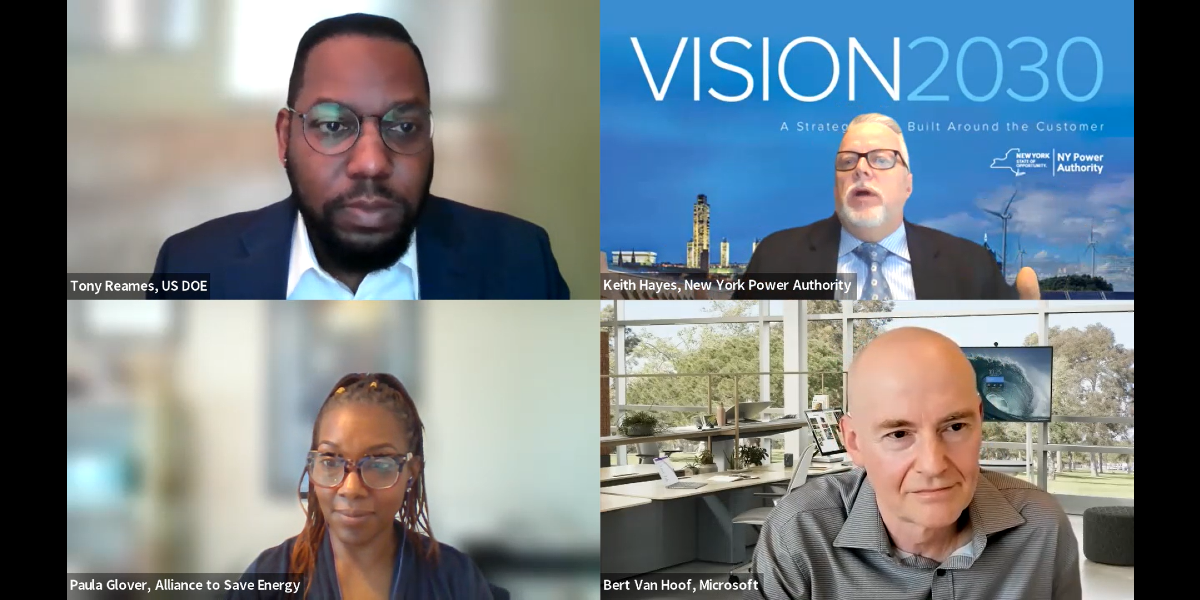The Future of Energy Efficiency: Active Efficiency at EFX22
Let's Save Energy
Alliance to Save Energy's Blog

We are facing a defining moment in our energy system. While traditional energy efficiency has been essential for keeping energy use and emissions in check for decades and will continue to be the foundational base moving forward, critical considerations such as climate, grid resilience, and equity issues call for leveraging all the tools at our disposal. That’s why when we at the Alliance discuss the future of energy efficiency, we point toward the power of Active Efficiency technologies.
On April 15, Alliance President Paula Glover met with industry leaders to discuss the future of Active Efficiency at Efficiency Exchange 2022, hosted by Alliance Associate Northwest Energy Efficiency Alliance. Glover was joined by Tony Reames, Senior Advisor in the Office of Economic Impact and Diversity at the U.S. Department of Energy; Bert Van Hoof, Microsoft Partner and General Manager in Azure; and Keith Hayes, Senior Vice President of Clean Energy Solutions at New York Power Authority. These three panelists shared their thoughts on Active Efficiency deployment strategies and the pressing issues of equity and energy security.
Here are three takeaways from the session:
Bridging the digital divide
Despite experiencing acute energy burdens, many underserved communities have little access to energy efficiency investments, much less Active Efficiency technologies. The Department of Energy’s Tony Reames said much of his work involves identifying the underserved communities that can benefit from energy savings and determining how the federal government can deliver those benefits.
Reames said making energy efficiency more equitable will require the energy industry to “meet people where they are, [and] have hard conversations about what the clean energy future looks like.” He stressed that while doing so, the energy industry must make sure it is not “overburdening and putting things on the communities that have borne the burden of our energy system in the previous energy revolution.”
Tangible projects to bring energy efficiency to underserved communities can include workforce development programs to promote local energy efficiency jobs and partnering with local organizations. Bert Van Hoof, who is also co-chair of the Active Efficiency Collaborative Steering Committee, said Microsoft is promoting energy equity while constructing a new campus in Atlanta, GA, by dedicating a portion of its land toward affordable housing projects and supporting affordable internet access in the local community.
“We’re not only trying to be good citizens, but also think through these kind of interactions around Active Efficiency and how the private sector can participate in aggregation and make the local network more resilient as a result,” he said.
Supporting cybersecurity
As our energy grid becomes increasingly digitalized, it also becomes more at risk for cyber-attacks that could affect the energy supply of multiple buildings. Keith Hayes of NYPA said the power authority sees the danger of a hacker accessing the electrical grid.
"The more that we do get interconnected, the more that this threat is going to grow,” he said.
Reames highlighted cybersecurity investments included in the Infrastructure Investment and Jobs Act passed in November. These funds support a team at the Department of Energy focused on supporting grid cybersecurity.
Ensuring cybersecurity starts with intensive monitoring of anomaly detection in the grid, Van Hoof said. Any anomalies found must be shut down or reported. However, cybersecurity measures become more complicated as connection evolves from the grid to buildings to integration layers like digital twins.
“As we talk about grid-interactive efficient buildings and [demand response] aggregation, this is paramount,” he said. “We can’t do this without deeply addressing the cyber aspect.”
Building trust with customers
For communities that have endured negative experiences with utilities in the past, accepting new Active Efficiency technologies can be difficult. Customers may be concerned they will lose agency with Active Efficiency technologies, and that utilities may be able to switch off their power more easily through the use of devices like smart meters.
Hayes said that building relationships with customers starts with educating them on how Active Efficiency technologies work and what the benefits are. Utilities and energy service providers must work with communities to become seen as a trusted energy advisor by finding co-development solutions.
“If you’re not seen as that partner, that representative, then there’s always going to be that skepticism,” he said.
Reames highlighted a Detroit project that utilized “energy efficiency Tupperware parties” to showcase Active Efficiency technology successfully installed in a neighbors’ home to the local community. Representatives from the local utility provider were also present to explain different energy rate structures. Reames argued that strategies like this are necessary to “take the extra step” and reframe the customer-utility relationship on both sides.
“It is taking the extra time so people use the programs efficiently and effectively, but so they also understand it and are comfortable with it,” he said.
To learn more about the Active Efficiency Collaborative, visit activeefficiency.org or reach out to activecollab@ase.org. Join us for a further discussion on Active Efficiency at EE Global 2022.
STAY EMPOWERED
Help the Alliance advocate for policies to use energy more efficiently – supporting job creation, reduced emissions, and lower costs. Contact your member of Congress.
Energy efficiency is smart, nonpartisan, and practical. So are we. Our strength comes from an unparalleled group of Alliance Associates working collaboratively under the Alliance umbrella to pave the way for energy efficiency gains.
The power of efficiency is in your hands. Supporting the Alliance means supporting a vision for using energy more productively to achieve economic growth, a cleaner environment, and greater energy security, affordability, and reliability.



